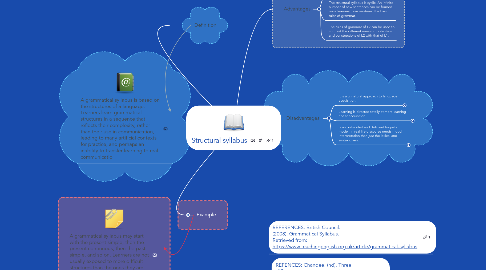
1. Example
1.1. Stakeholders
2. Definition
3. A grammatical syllabus is based on the structures of a language. Learners learn grammatical structures in a sequence that reflects their complexity, rather than their use in communication, leading to many artificial contexts for practice, and perhaps an inability to transfer learning to real communicatio
4. A grammatical syllabus may start with the present simple, then the present continuous, then the past simple, and so on. Learners are not usually exposed to more difficult structures than the ones they are learning.
5. Advantages
5.1. It is made up of units that are "capable of being broken down into descrete elements".
5.2. The structural syllabus is cyclic. An infinite number of new sentences can be formed once learners have mastered the basic rules of grammar.
5.3. The rules of grammar of L2 can be used to contrast the different meaning potentials and constructions of L2 with that of L1.
6. Disadvantages
6.1. It is a unnatural approach to language acquisition.
6.1.1. Situational Analysis / Drivers
6.1.1.1. What is driving us to do this?
6.1.1.2. SWOT Analysis
6.1.1.2.1. Strengths
6.1.1.2.2. Weaknesses
6.1.1.2.3. Opportunities
6.1.1.2.4. Threats
6.1.1.3. Customer Findings - What have we learned from customers?
6.1.2. Competitive Analysis
6.1.2.1. Do we have competitors and threats in these target markets with the proposed offerings?
6.1.2.2. What are our competitors doing and how are they positioning?
6.1.2.3. How do we position against each competitor?
6.1.3. Target Customer(s)
6.1.3.1. Buyer Profile
6.1.3.1.1. Title
6.1.3.1.2. Industry
6.1.3.1.3. Geography
6.1.3.1.4. Business Size
6.1.3.2. Influencer Profile
6.1.3.3. User Profile
6.1.3.4. What do customers want and need?
6.1.3.5. What business problems do each of these customers have?
6.1.4. Customer Segmentation
6.1.4.1. Which customers or sets of customers do we sell to?
6.1.4.2. What are the target market segments that we want to go after?
6.1.4.3. What are the distinct problems for each segment of the market?
6.1.5. Total Available Market
6.1.5.1. New Prospects
6.1.5.1.1. How much of each target segment have we penetrated?
6.1.5.1.2. How much opportunity is available in each target segment?
6.1.5.2. Existing Customers
6.1.5.2.1. Can we up-sell existing customers?
6.2. Learning is directed totally at mere learning not at acquisition
6.2.1. Service Offer
6.2.1.1. What are we selling?
6.2.1.2. Product Definition
6.2.1.3. Pricing
6.2.1.4. Packaging
6.2.1.5. Positioning
6.2.2. Value Proposition
6.2.2.1. What is the Value Proposition to the Customer?
6.2.2.2. What pain are we solving?
6.3. Is an outmoded and deficient lingustic model. In real life discourse needs mood interpretation than just the lexical and syntax given.
6.3.1. Sales Strategy
6.3.1.1. Direct Sales Strategy
6.3.1.2. Inside Sales Strategy
6.3.1.3. Channel Sales Strategy
6.3.2. Partner Strategy
6.3.2.1. Channel Strategy
6.3.2.1.1. What 3rd party channels should we consider for reselling this service?
6.3.2.2. Technology Partnerships
6.3.2.2.1. What technology vendors (if any) do we need to work with to execute on this plan?
6.3.2.3. Solutions Partners
